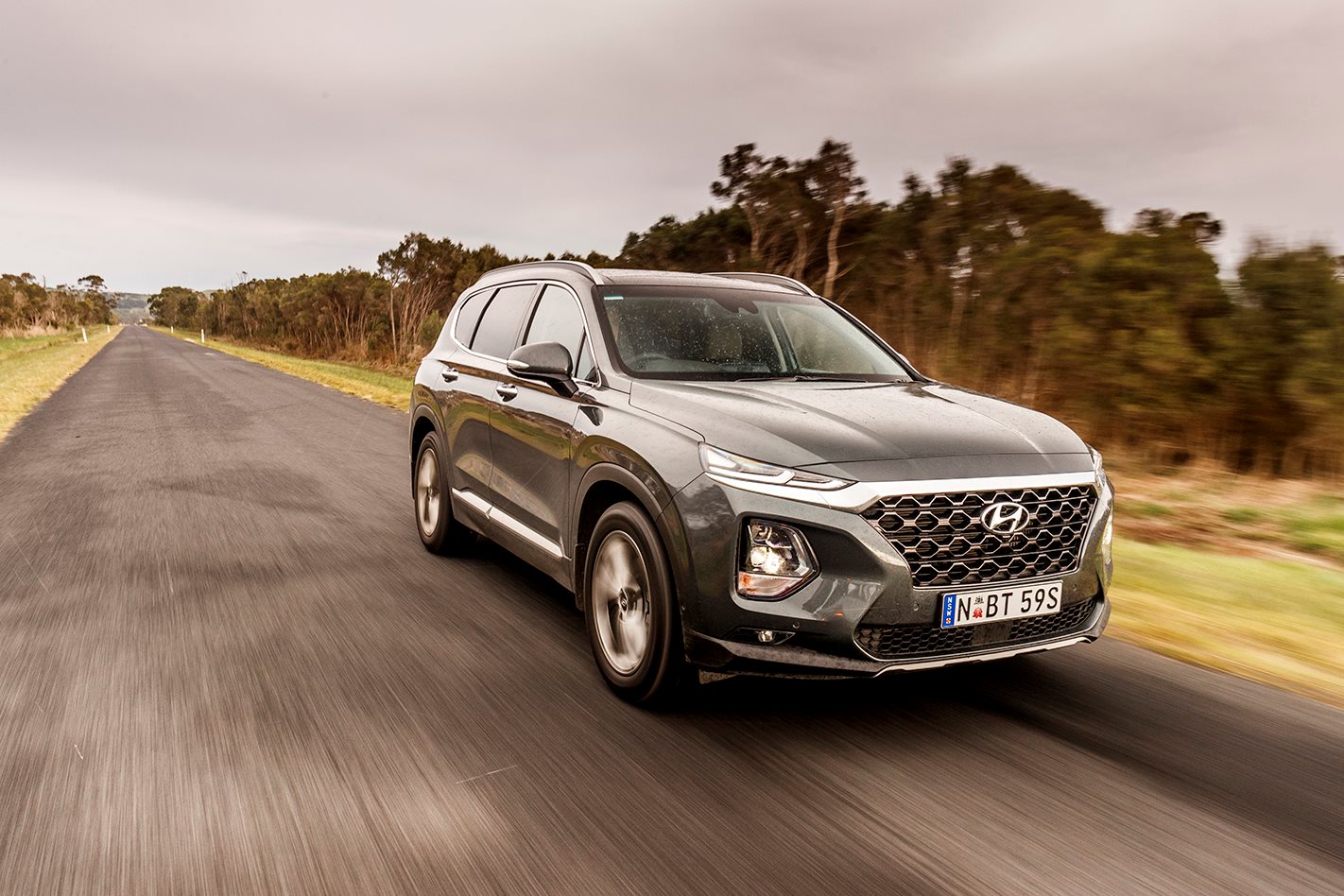
Score breakdown
Things we like
- Excellent diesel engine
- Stylish interior
- Auto braking
Not so much
- Airbags don’t cover third-row passengers
What stands out?
The fourth-generation Hyundai Santa Fe is a seven-seat, road-focused SUV with sharp handling and a choice of engines – a fuel-efficient diesel and powerful V6 petrol. It is well suited to long journeys, and comfortable for families who like to get out of town. Some Santa Fes drive all four wheels, and all come with autonomous emergency braking and have excellent phone connectivity.
Something newer…
STORY CONTINUES
What might bug me?
Trying to fit luggage belonging to all seven occupants into the tiny boot space with the third row in use.Copping a speeding fine because the speed limit display on the satellite navigation and head-up display, in the Elite and Highlander, is out of date or doesn’t consider variable speed zones.That the Santa Fe’s head-protecting, side-curtain airbags do not extend to passengers in the third row of seats.
What body styles are there?
Five-door wagon only.Diesel Santa Fes use an on-demand AWD system, which optimises fuel consumption. They drive the front wheels all the time, and distribute power to the rear wheels when that’s helpful. To improve performance at slow speeds in slippery going, you can lock-in 50-50 power distribution to the front and rear wheels by pressing a button on the dash. Petrol Santa Fe versions drive the front wheels only.The Santa Fe is classed as a large SUV, lower priced.
What features does every Santa Fe have?
- Adaptive cruise control, which automatically matches the speed of a slower car ahead on the highway and resumes your set speed when the way is clear. It also has a ‘stop and go’ feature that holds your place in stop-start traffic, halting and restarting the car as required.)
- A reversing camera, and rear parking sensors.
- Automatic transmission.
- Support for Apple CarPlay and Android Auto, which lets you display mapping and other apps from a compatible smartphone on the car’s touchscreen, and control them from there.
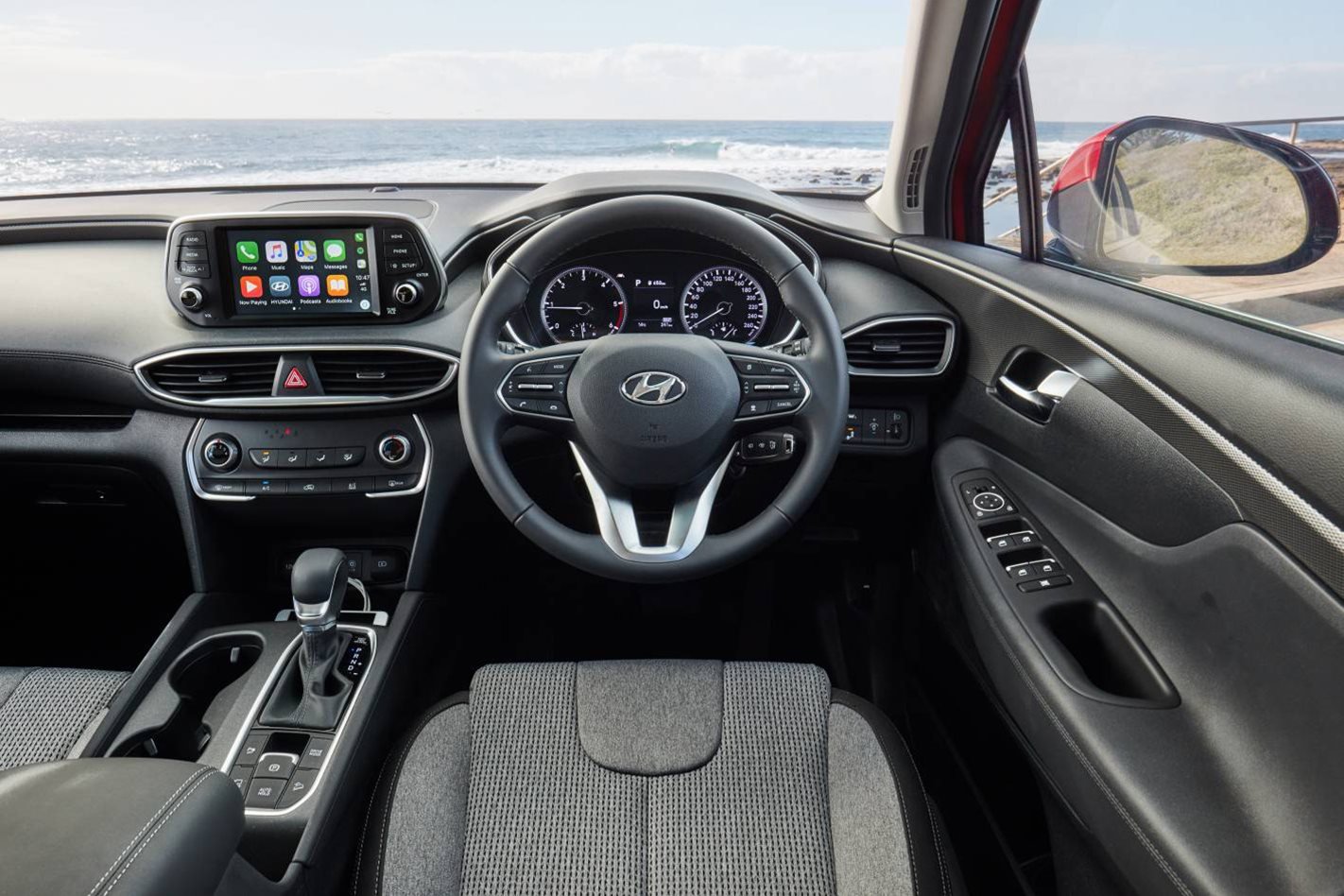
- A sound system with an AM/FM radio, Aux and USB inputs, Bluetooth phone connectivity and audio streaming, and at least six speakers, controllable from a colour central touchscreen.
- Broadly effective autonomous emergency braking, as part of Hyundai’s SmartSense active safety suite – which also brings you a lane keep assist, blind-spot detection, driver attention warning and a rear cross-traffic alert.
- Headlamps that come on automatically at night or in a tunnel.
- Automatic high-beam assist, that dips the lights in built-up areas and for oncoming traffic. LED daytime running lights, and front and rear fog-lights.
- A leather-clad steering wheel, from which you can operate the cruise control and audio system. (If you have a compatible smartphone plugged in, you can also switch on voice control from the wheel.)
- Air-conditioning with rear temperature controls.
- Electric switch on second-row backrests for one-touch flip-and-slide access to the third row.
- Aluminium alloy wheels, which are lighter than steel wheels and don’t need plastic trim, and a matching full-sized spare wheel.
- Adjustable drive mode with four settings including Eco, Comfort, Sport and Smart that alter steering weight and engine revs accordingly.
- Hill-start assist.
- Roof rails
- Six airbags. Anti-lock brakes, and electronic stability control – which can help control a slide or skid. (For the placement of airbags, and more on Santa Fe safety features, please open the Safety section below.)
Which engine uses least fuel, and why wouldn’t I choose it?
Each version of the Santa Fe comes with a choice of two engines, a 3.5-litre V6 petrol engine, and a 2.2-litre turbo diesel. There was a 2.4-litre four-cylinder petrol engine available with the Active version, but this was deleted from the range in December 2019 for the 2020 model year.The diesel is the most fuel-efficient and uses 7.5 litres/100km in the official test (city and country combined). In real-world driving you might not match this figure, but you could get close if you drove gently and did plenty of country trips.The main reason you would not choose the diesel is that it adds about $3000 to the price of a Santa Fe, though it is worth noting that this price includes all-wheel-drive traction.Another reason is that you prefer more power. Santa Fes with the petrol V6 are quicker than diesels, but they are also thirstier. On the official test, the V6 consumes 10.6 litres/100km. In the real world, expect to average 13-14 litres/100km over a mix of city and country driving.The V6 petrol Santa Fes are front-wheel-drive only.All Santa Fes come only with an eight-speed automatic gearbox.Power outputs and all other specifications for each Santa Fe can be reached from the Cars covered carousel near the top of this review.
What key features do I get if I spend more?
All four Santa Fe versions come with the 3.5-litre V6 petrol engine and front-wheel drive as standard, with the all-wheel drive diesel powertrain costing about $3000 more.
The least costly Santa Fe is the Active, which has cloth seats, 17-inch alloy wheels, a 7.0-inch touchscreen, and all the features common to all Santa Fes.
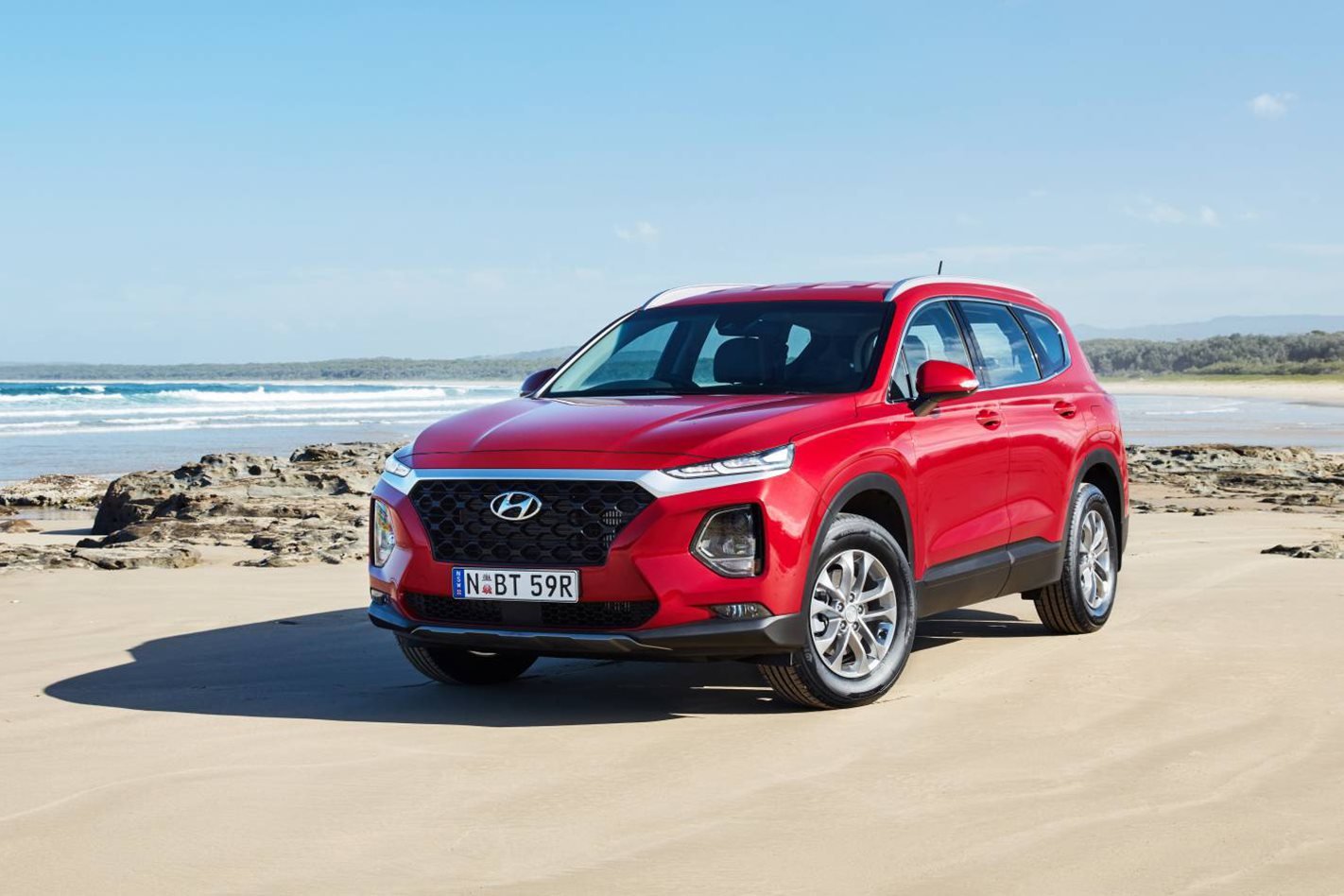
If you want more comfort you need to shell out for a Santa Fe Active X, which brings:
- Leather-appointed interior trim.
- Bigger 18-inch alloy wheels.
- Front parking sensors.
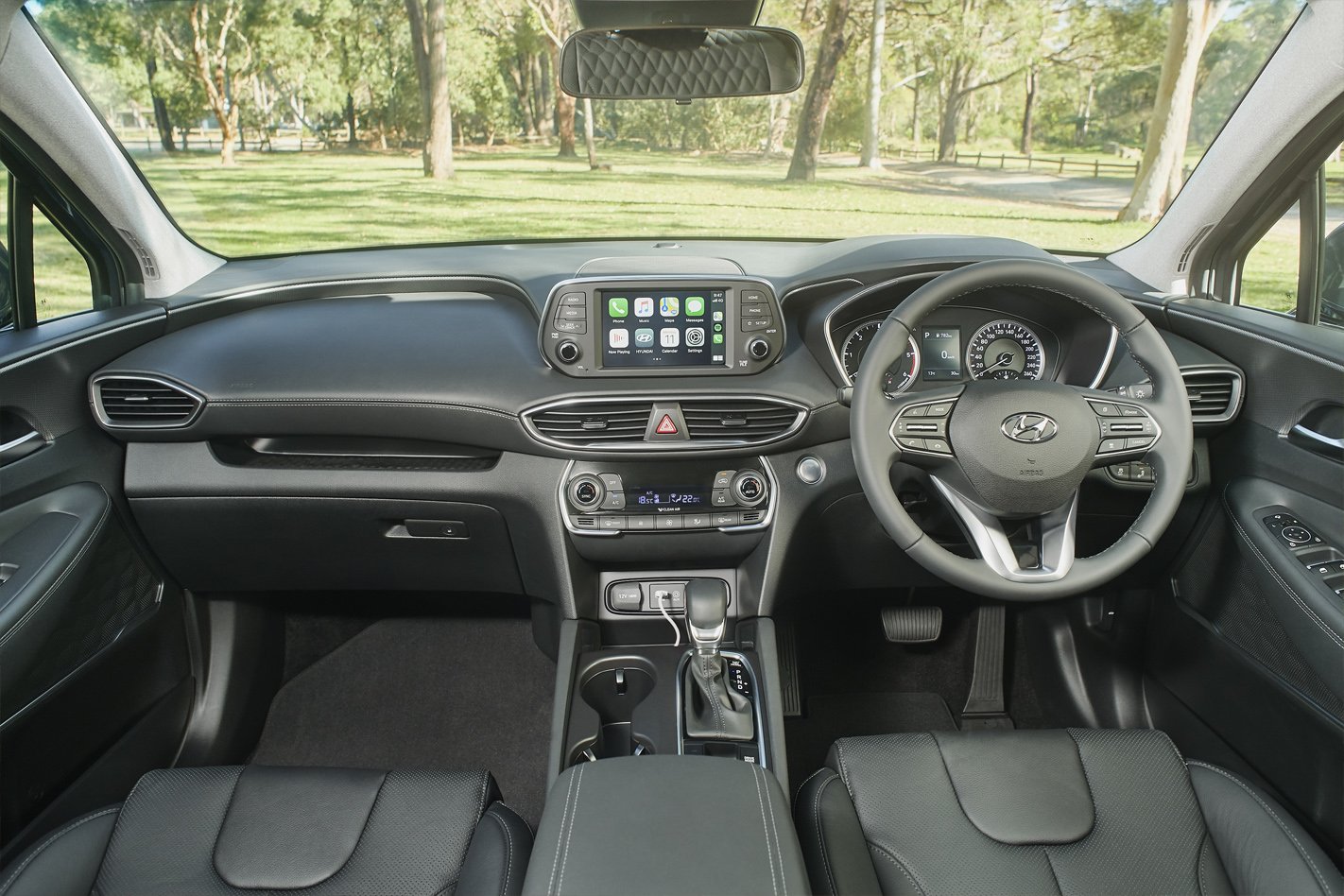
- Smart key with push-button start.
- Dual-zone climate control with automatic defog.
- Glovebox compartment cooling.
- Rain-sensing windscreen wipers.
- Puddle lamps integrated into exterior mirrors.
- Power folding exterior mirrors.
- Heated and power-adjusted front seats – with 10-way settings for the driver’s seat, and 8-way for the passenger.
- A bigger 8.0-inch touchscreen.
- DAB+ digital radio.
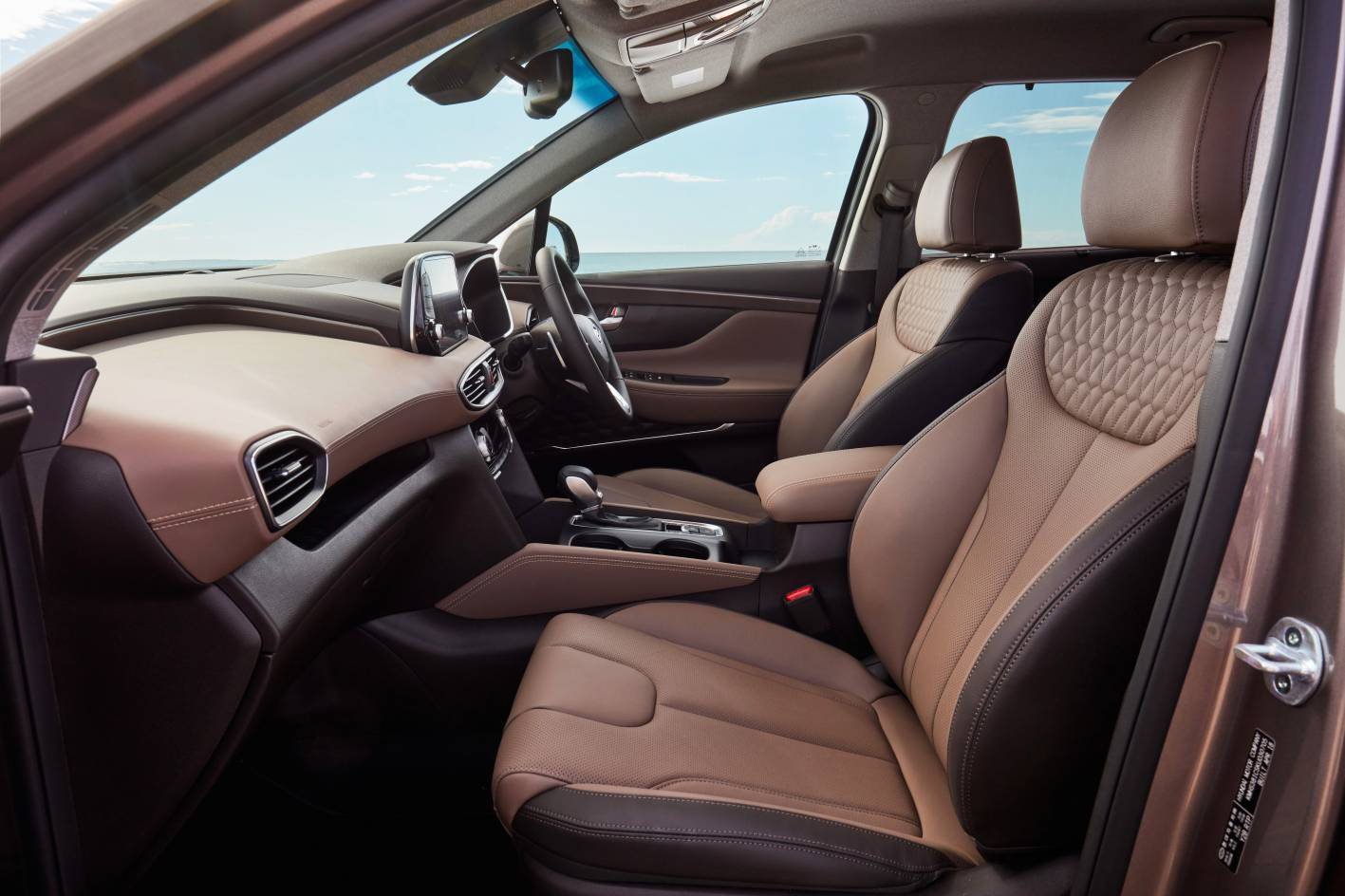
- Satellite navigation that does not depend on your phone.
- Power-operated tailgate that unlocks and rises automatically if the key is nearby for three seconds.
- 10-speaker sound system with external amplifier and a bass-boosting sub-woofer.
- Blinds for the middle row seats.
- Steering wheel paddle shifters.
- A head-up display shows speed, adaptive cruise control and sat-nav information on the windscreen near your eyeline.
- 360-degree view parking monitor.
- Panoramic sunroof that covers the front and rear seats.
- Heated and ventilated front and outboard middle-row seats.
- Heated steering wheel.
- 14-way power adjusted driver’s seat including under-thigh cushion extension and memory settings that also recall the door mirror and head-up display position
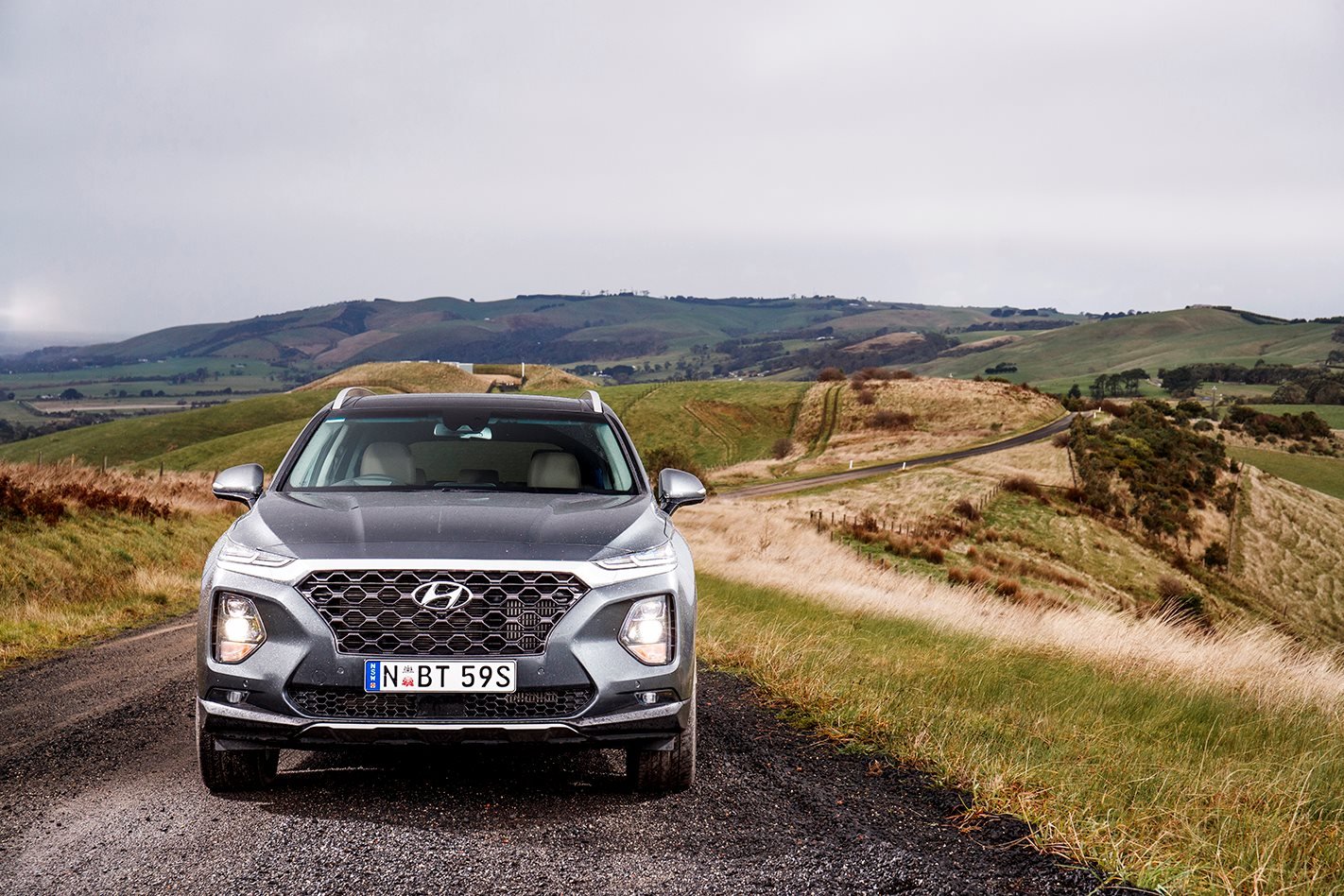
- Sharper LED interior lighting.
- Wireless charging pad for compatible smartphones.
- Extremely bright HID headlamp units that shine into corners.
- LED tail-lights and front-fog-lights.
- A self-parking system can automatically steer the car into or out of a space while the driver controls the throttle and brake.
Does any upgrade have a down side?
The steps up in wheel size – from 17-inch on the Active to 18-inch on the Active X and Elite and 19-inch on the Highlander – reduce ride quality slightly, because the lower profiles of the bigger tyres leave less air between the wheel and the road.White Cream and Stormy Sea are the only standard colours, with the other seven costing extra.
How comfortable is the Santa Fe?
Any Santa Fe looks elegant inside, with well-crafted interior that’s a big improvement over its plasticky predecessor. The overall interior design errs on the side of conservatism but gives a strong impression of quality. The seats feel plush, with the front seats offering long bases under your thighs.The driver’s seat adjusts for height, and has power-adjustable lumbar (lower back) support in all versions, with power settings in the Active X, Elite and Highlander.
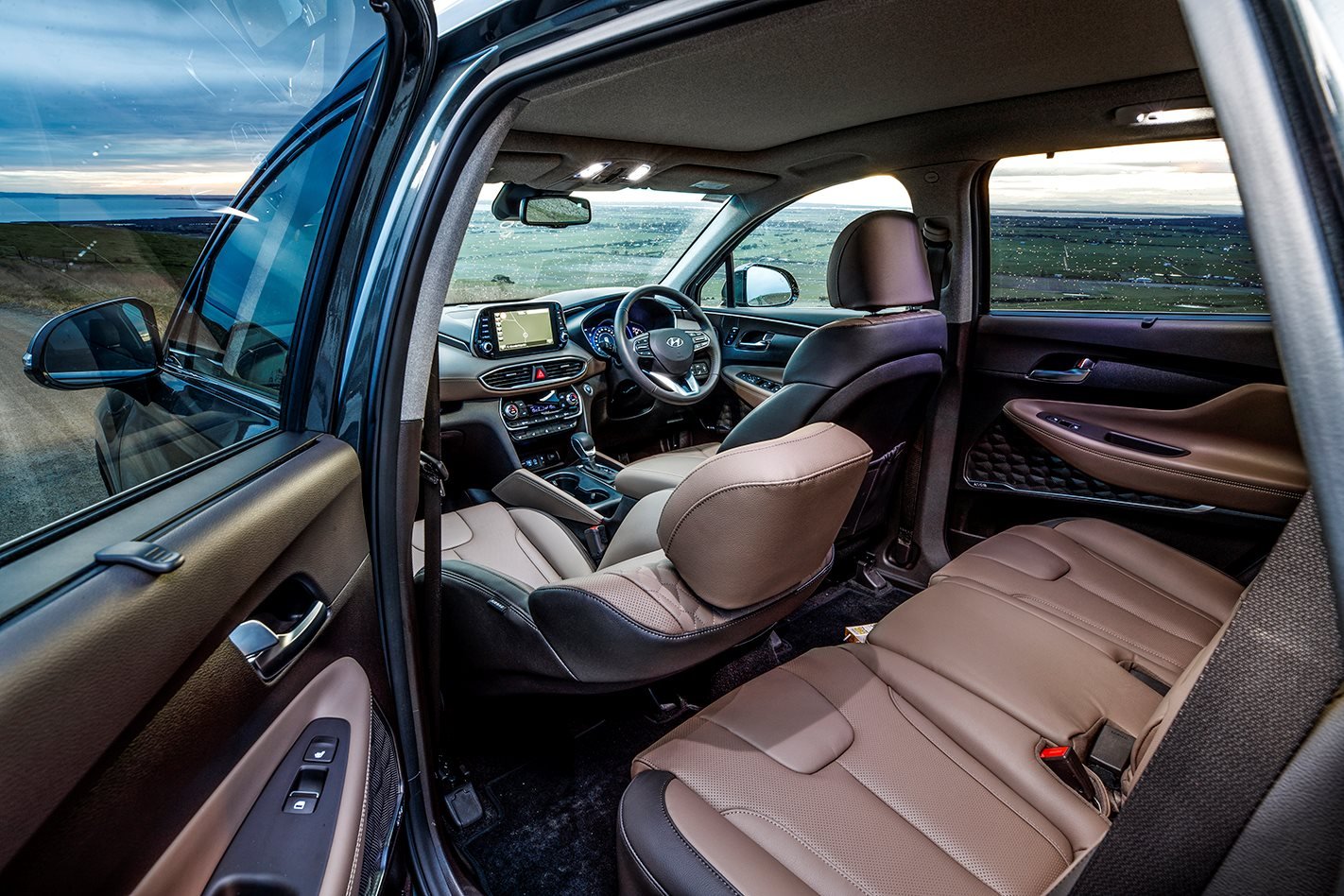
A pleasing mix of textures and stitching lift the new Santa Fe well beyond the Korean/Japanese norm, and even the entry-level Active’s cabin, with its cloth trim, holds some interest.
A deep storage compartment in the centre console has a removable shelf, and there is a big binnacle ahead of the gear lever with a 12v power outlet, and AUX and USB sockets. There is also a handy shelf above the glovebox for the front passenger to place their own items such as phone and keys.On any Santa Fe you can plug in a compatible smartphone and operate several apps via Apple CarPlay or Android Auto – from maps to music and text messages – via the touchscreen or (if you’re driving) by voice. A button on the steering wheel lets you toggle the voice control system built into your phone.
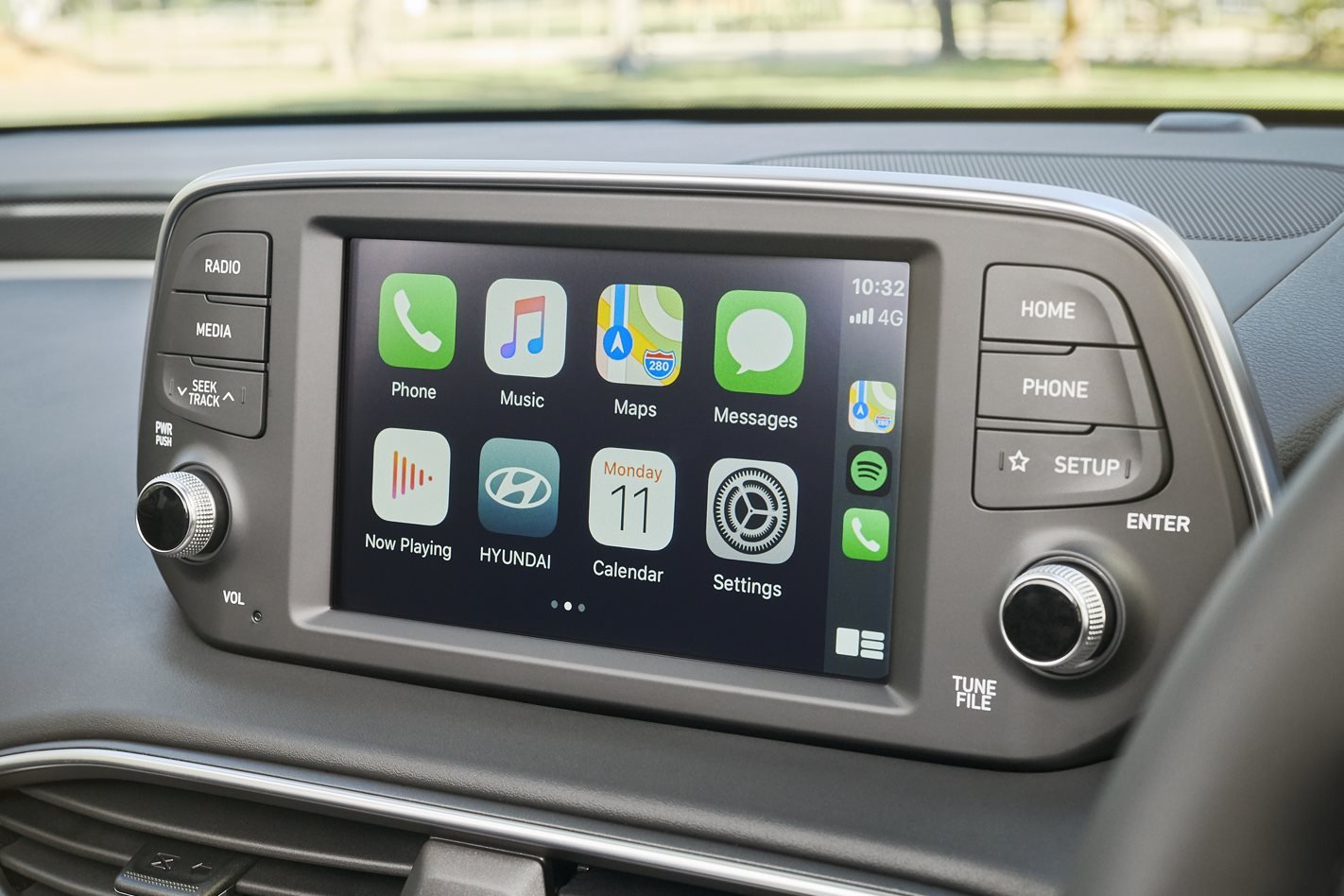
What about safety in a Santa Fe?
Every Santa Fe has anti-lock brakes, stability control, seven airbags, LED daytime running lights, auto- headlights and wipers, a reversing camera, and rear parking sensors.In addition, all Santa Fes have Hyundai’s SmartSense active safety suite, which brings autonomous emergency braking and lane keep assist, blind-spot detection, driver attention warning and a rear cross-traffic alert.The auto-braking on Santa Fes is a broadly effective system that draws on radar and camera sensors and (Hyundai says) can detect pedestrians. If it predicts a collision with an obstacle in front (typically a sharply slowing car), it sounds and flashes a warning. If you ignore that, it will brake the car automatically. At speeds under 80km/h it will brake very sharply; at speeds in the range 80-180km/h, less sharply – but you can of course apply maximum braking yourself.There are two airbags at the front for frontal impacts; one outside each front-seat occupant to protect the body in side crashes; and a curtain airbag down each side to protect heads in a side impact. The side-curtain airbags cover only passengers in the front and second-row seats, however. No one riding in the third row has airbag protection.Rear Occupant Alert lets you know if someone has vacated one of the second or third row seats before you drive off without them, while Safe Exit Assist warns you of any oncoming traffic as you exit the Santa Fe.The Australasian New Car Assessment Program (ANCAP) has yet to assess the fourth-generation Hyundai Santa Fe.
I like driving – will I enjoy this car?
The Santa Fe achieves a pleasing level of dynamic agility for an SUV this size.The chassis is much more compliant than the previous model’s and the new rack-mounted electric power steering and standard (on-demand) all-wheel drive combine with extensive Australian suspension tuning for a much more well-rounded driving experience – one that now manages to achieve both ride and handling adeptness, without one being detrimental to the other.
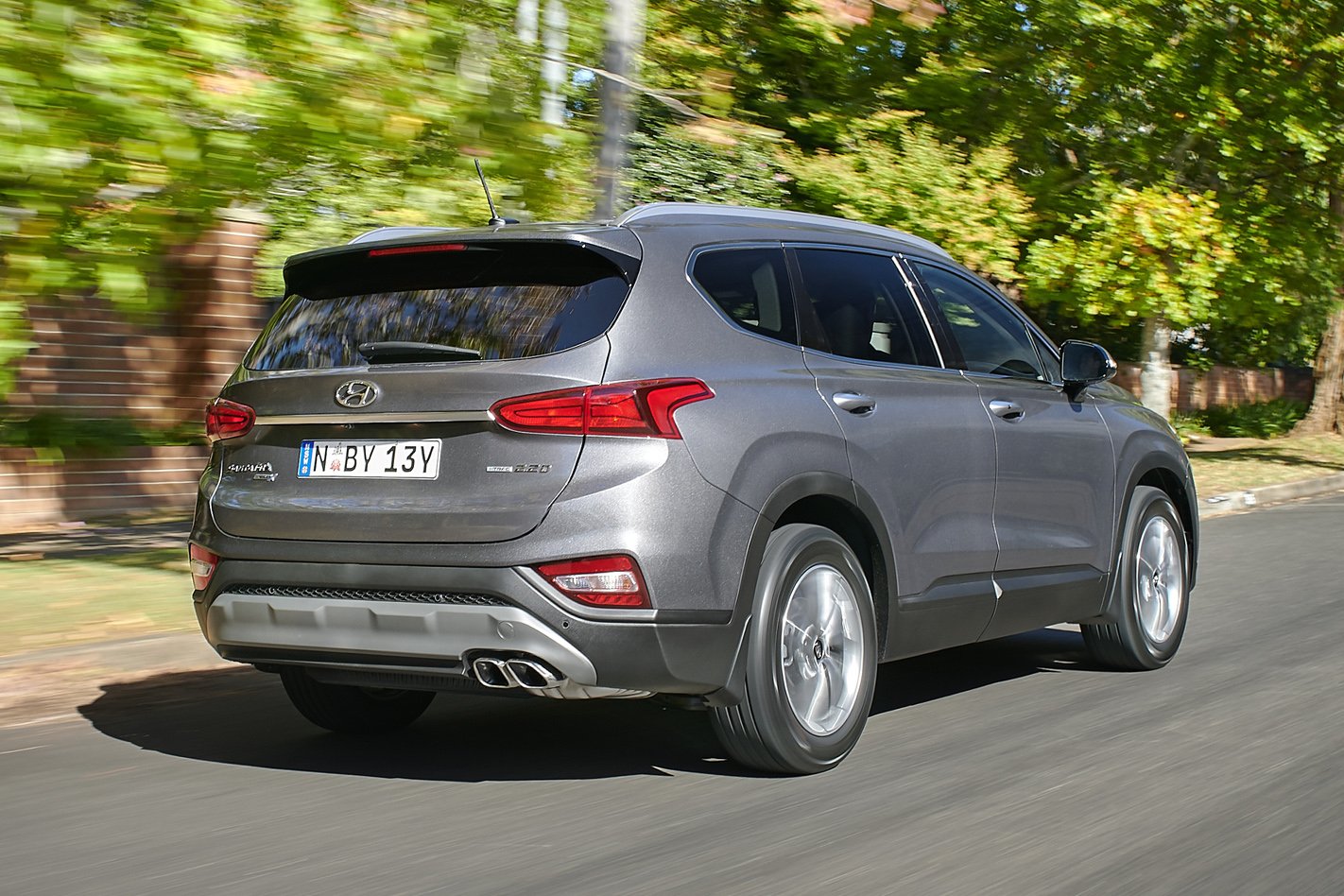
The 2.2-litre turbo-diesel is also carry-over, but the eight-speed automatic transmission is new making this powertrain a far better match for the Santa Fe, with seamless gear shifts and a decent 440Nm of torque. It has great punch, especially in Sport mode, which makes overtaking easy.All Santa Fes drive all four wheels, but the on-demand all-wheel-drive is more about better traction on slippery surfaces (such as snow or gravel) than tackling rugged trails. If you do get off the beaten track, you have the security of a full-sized spare tyre.
How is life in the rear seats?
In the middle row it’s really good. A wide seat easily allows for three across it (that middle person will be perched higher, due to the shape of the outer seat cushions). There’s great headroom and plenty of room for big feet under the front seats. Little touches, such as the mild scalloping in the backs of the front seats, ensure good legroom too, and if you want even more you can slide the middle seats rearwards.The Santa Fe Highlander also has heating for the middle-row outboard seats, and mesh window blinds that will keep sunlight off a sleeping child.
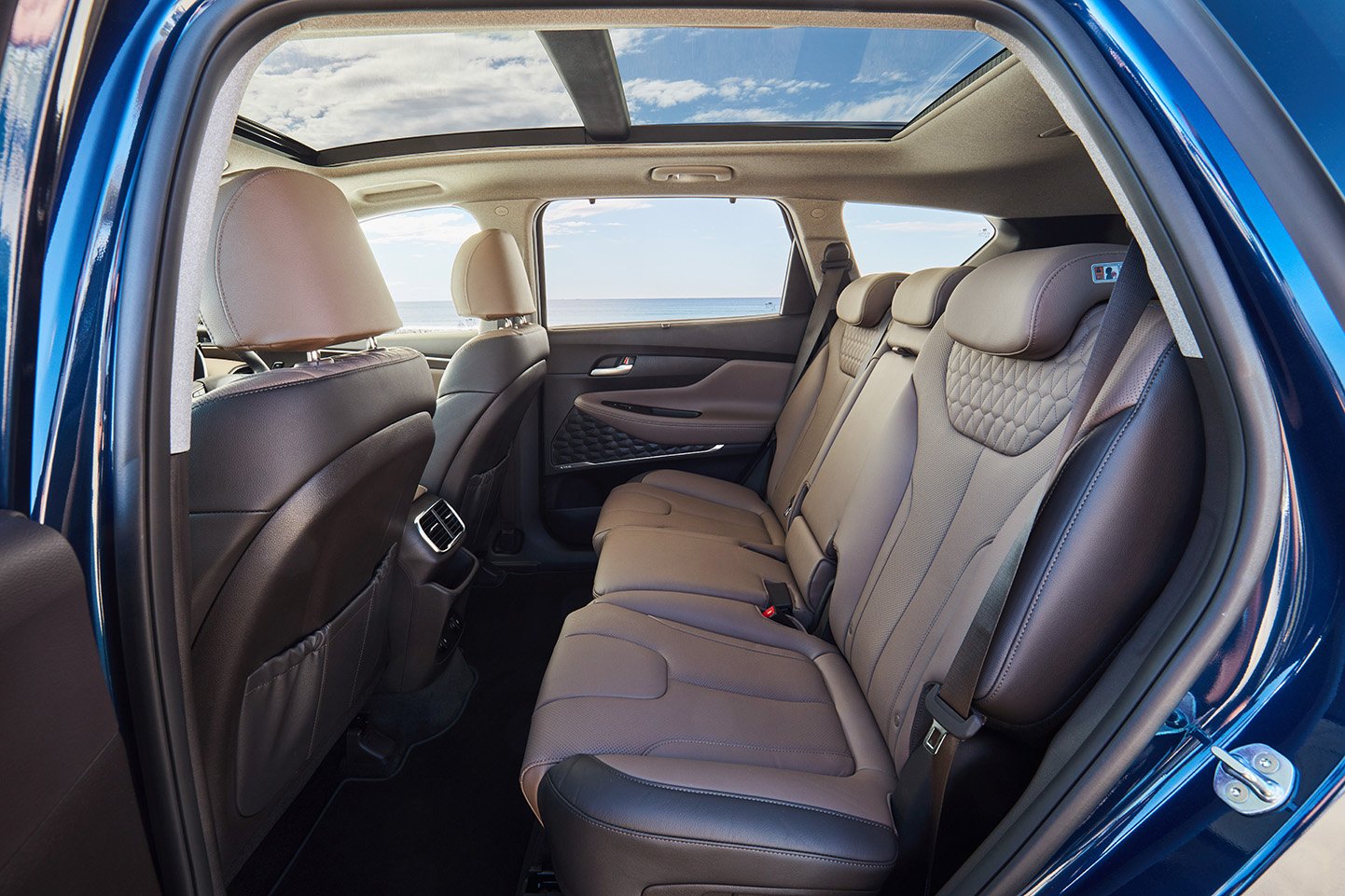
That third-row seat is much tighter for room than the second, but it’s an improvement over the previous models, with occupants no longer finding their heads underneath the tailgate glass.
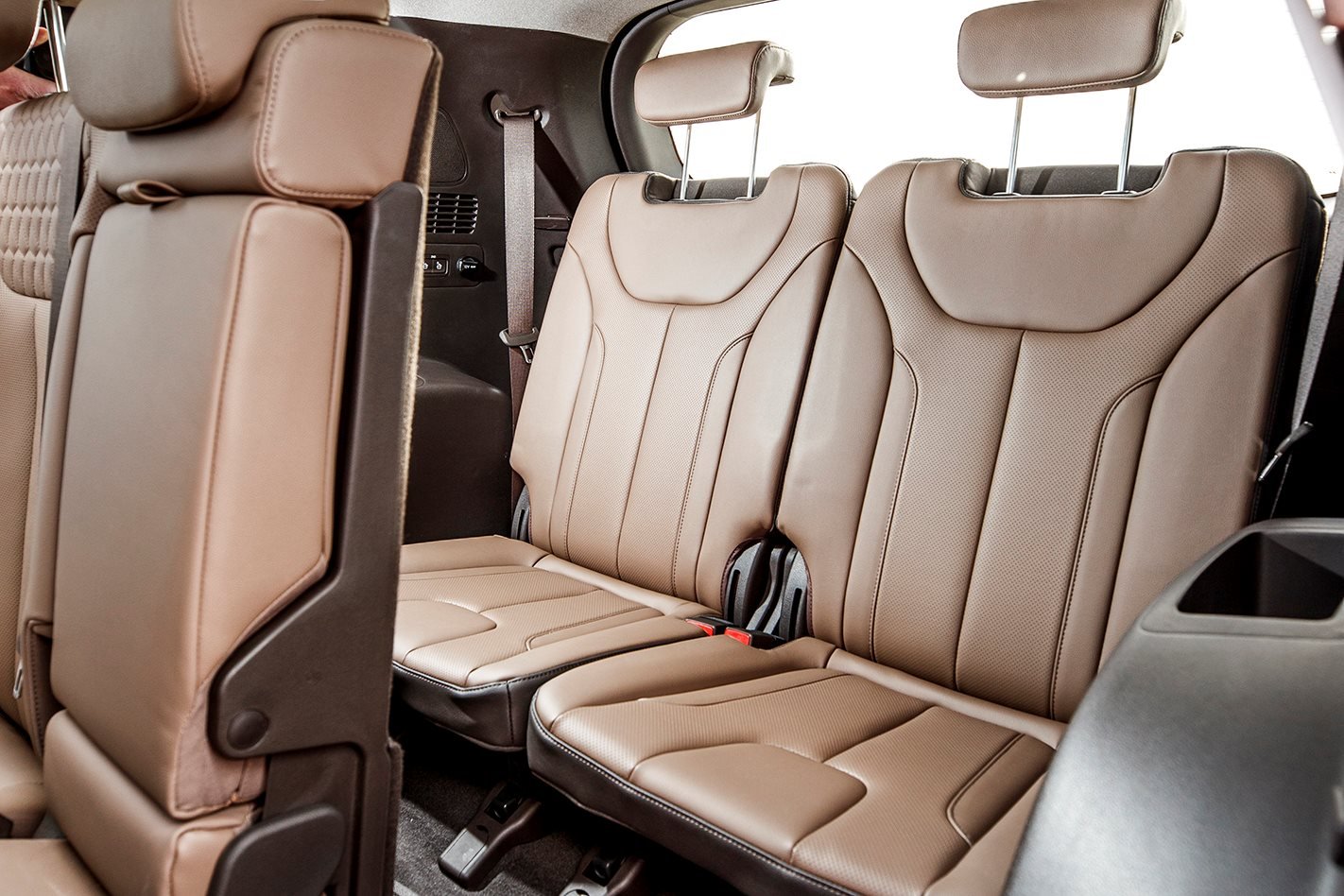
How is it for carrying stuff?
With all seven seats in use there is only 130 litres of boot space, which is less than a third of most small hatchbacks, and will fit a couple of soft bags. There’s some additional space under the floor for small items.
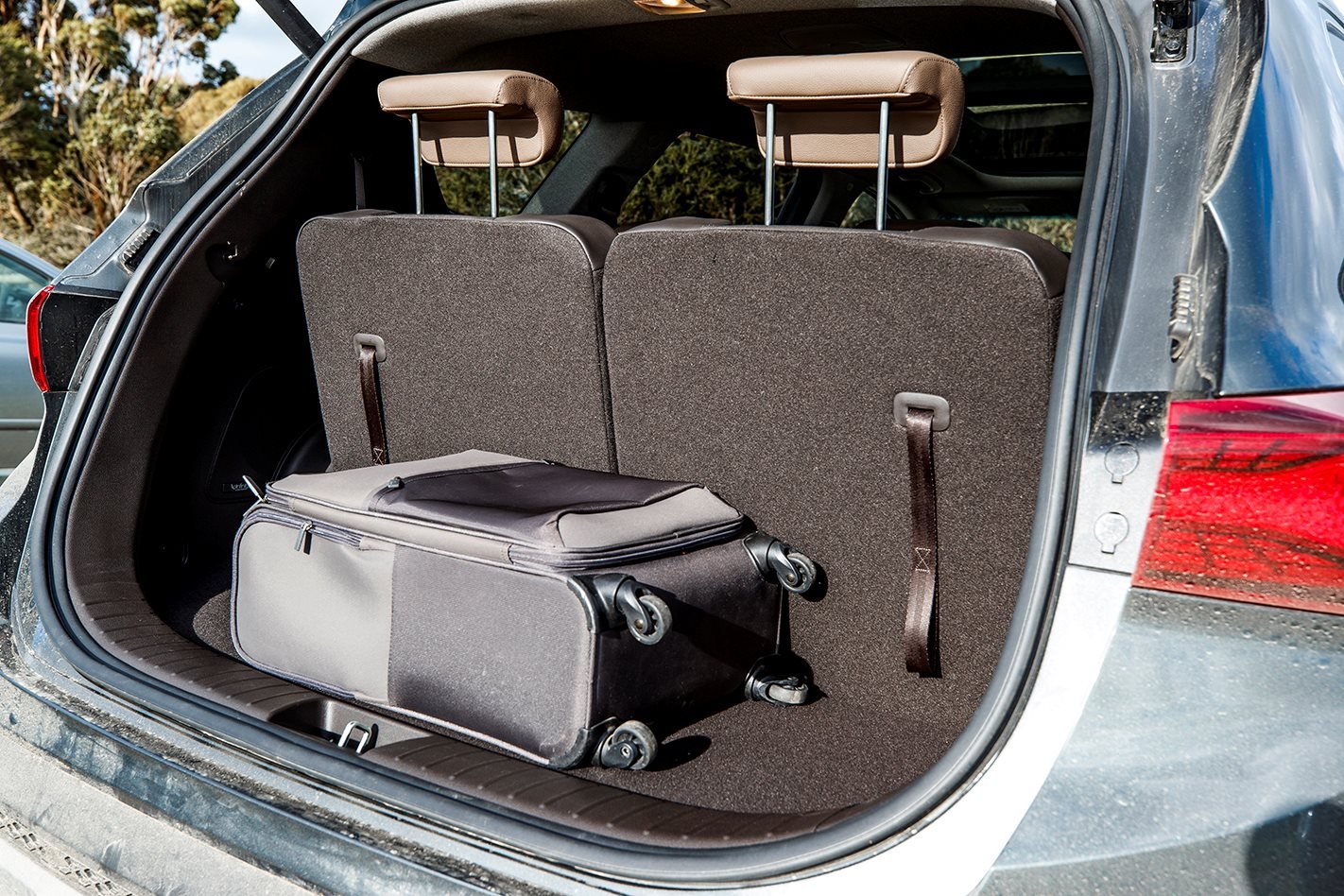
The middle row seats split-fold in a 40-20-40 configuration, which is great for flexibility. You can flip just the centre section, for example, to accommodate a long item, and still have two comfy outer seats. Pushing all the second-row backrests down brings a handy 1647 litres.The tailgate rises very high, so there’s no stooping to load stuff in the back. The Elite and Highlander have hands-free tailgates that add convenience when your arms are full of cargo.
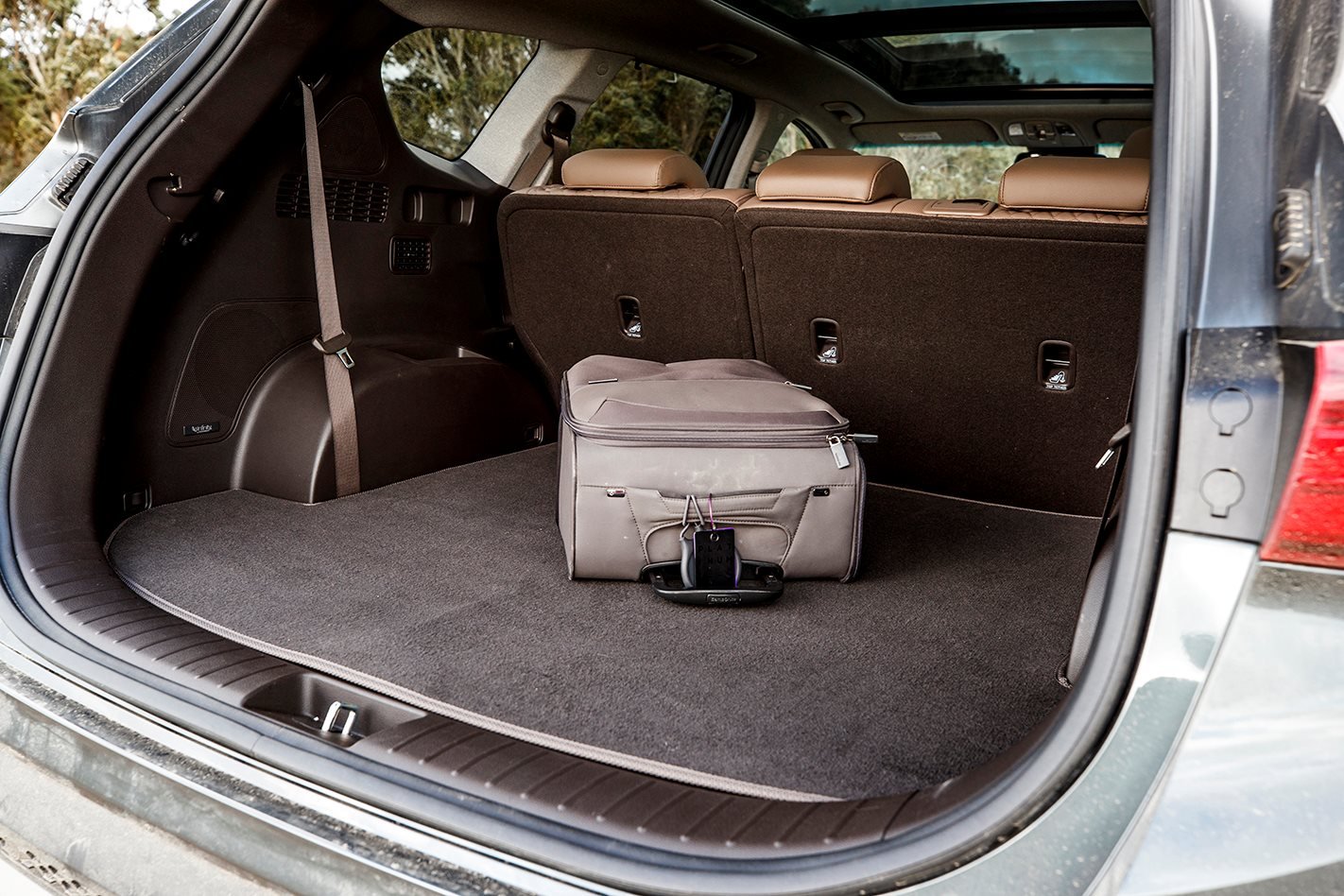
There’s no shortage of cabin storage, which includes a large centre console and nooks for the driver and front passenger, cup holders in all three rows, and door bins with bottle bulges at the front and back.
The Santa Fe can tow up to 2000kg and has a 100kg tow ball weight.
Where does Hyundai make the Santa Fe?
All Santa Fes are produced in South Korea.
What might I miss that similar cars have?
Curtain airbags that protect passengers in the third row of seats against side impacts – such as fitted to the Toyota Kluger, Mazda CX-8, Mazda CX-9, Nissan Pathfinder and Peugeot 5008.A more economical turbocharged petrol powertrain as in the CX-9 and Skoda Kodiaq.Among other seven-seat SUVs you might consider is Kia Sorento, which uses the same diesel and petrol powertrains as the Santa Fe as well as a 2WD petrol V6, and also shares many of the Hyundai’s infotainment and driving displays.
If carrying seven people in comfort is a high priority, and use off-tarmac is not, it could be worth taking a look at the Kia Carnival.
In contrast, if you would contemplate trading some on-road comfort and precision for the ability to tackle rough tracks off-road, you might want to look at the Ford Everest and the Toyota Prado or Toyota Fortuner, all of which offer seven seats.
Are there plans to update the Santa Fe soon?
The fourth-generation Hyundai Santa Fe arrived in July 2018, with plenty more cabin and driving refinement than the previous model, albeit with the same 2.4-litre petrol and 2.2-litre diesel engines as before.In December 2019 Hyundai dropped the lacklustre 2.4-litre petrol, which was only available in the entry-level Active version, and introduced the more powerful V6 that proved popular in the previous model’s Active X variant. Unlike before, the V6 was made available across the Santa Fe range.
In July 2020, Hyundai reintroduced the Active X variant that added some luxury extras to the Active spec.
The fifth-generation Santa Fe (below) is expected to arrive in 2021 which will likely share features with the new-generation Kia Sorento.
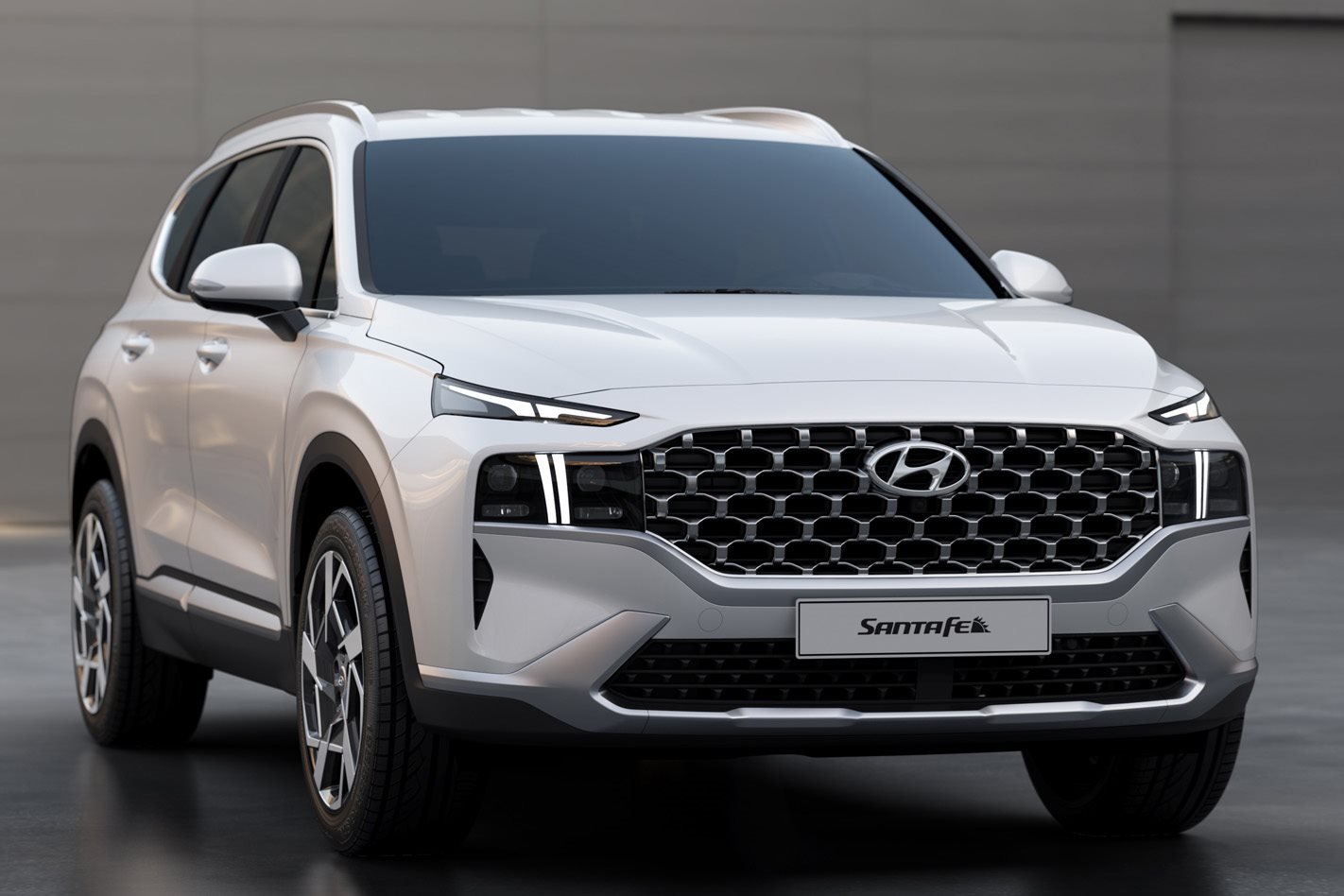
I like this car, but I can’t choose which version. Can you help?
Any of the AWD diesel Santa Fes are a good bet, but the mid-spec Active X provides the sweet spot in terms of pricing and features, though spending $5000 on the Elite does bring some desirable extras.
Score breakdown
Things we like
- Excellent diesel engine
- Stylish interior
- Auto braking
Not so much
- Airbags don’t cover third-row passengers



